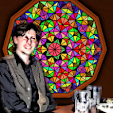Óðinn ok Frigg sátu í Hliðskjálfu ok sá um heima alla.(from the prose introduction to the Grímnismál in the Poetic/Elder Edda)"Odin and Frigg sat in the Hlithskolf ("Gate-Shelf") and looked over all the worlds."
This small figurine, which was found by the local amateur archaeologist Tommy Olesen on 2 September 2009 during Roskilde Museum’s excavations at the small village Gammel Lejre, is the first Viking-age depiction of Odin in his seat Hliðskjálfu:

Odin (Óðinn) figurine found in Lejre
(silver with inlays of niello)
[early 10th century]
Weight: 9 grams
Height: 17.5 mm
Width: 19.8 mm
Depth: 12.4 mm


Odin enthroned on his seat Hliðskjálf, from which he may see into all the worlds.
Notable features:
- Left-eye appears to be damaged ["Old One-Eye"].
- Two ravens sit on the throne [Odin's ravens: Huginn ("Thought") and Muginn ("memory")].
- Behind the throne are two dogs?/wolves? [Odin's wolves: Geri ("ravenous one") and Freki ("greedy one")].
- Necklace may represent Odin's ring, Draupnir ("the dripper"), a gold ring from which every ninth night falls eight gold rings of equal weight.
- This is the first early depiction of Odin on his throne Hliðskjálf ("gate-bench"?, "protection-bench"?).
The representation of Odin with both ravens and wolves is symbolic of his status as Valföðr "Father/Lord of the Slain" (as in Völuspá 1). Ravens and wolves (along with eagles) are a Germanic convention for representing the death and destruction of the battlefield. This "Beasts of Battle" theme (Magoun[1]) often appears in Germanic poetry, as in the following selection from Beowulf, from the end of the speech of the messenger who comes to tell the Geats of Beowulf's fall during his fight with the dragon. The messenger predicts that without the protection of their king, the Geats will be slaughtered by their enemies (Old English wæl is cognate with Norse val):
Forðon sceall gār wesanmonig morgenceald mundum bewunden,hæfen on handa, nalles hearpan swēgwīgend weccean ac se wonna hrefnfūs ofer fǣgum fela reordian,earne secgan hū him æt ǣte spēowþenden hē wið wulf wæl rēafode.Beowulf ll.3021b-27bTherefore, many a spear,morning-chilled, shall be grasped in hand,held in fists; no sound of harpwill waken the warriors, but rather the black raven,eager above the doomed, will have much to say,to recount to the eagle, of how he feasted to the fullwhen he and the wolf looted the field of the slain.
Swedish archaeologist Dr. Martin Rundkvist argues that the figure is in fact Freya; for more discussion on this, see here and here.
References:
[1]Magoun, Francis P., Jr. 1955. "The Theme of the Beasts of Battle." Neuphilologische Mittelungen 56: 81-90.

another angle

The goddess Frigg and her husband, the god Odin, sit in Hliðskjálf and
gaze into look into "all worlds" and make a wager as described in Grímnismál.
[From Gjellerup, Karl. 1895. Den ældre Eddas Gudesange. Copenhagen: P.G. Philipsens Forlag.]


Beautiful, & awesome. An icon lining up with all those traits is cool as heck.
ReplyDeleteMy response is quite the contrary: the statuette is fuggly, and the ravens look more like ducks.
ReplyDeleteHmm...I thought the artist had quite skilfully captured the pose of ravens with their heads cocked.
ReplyDeleteIt's difficult for me to see these birds as ducks--in any case, I can't recall any Northern deities who are associated with ducks.
awesome. just awesome.
ReplyDeleteAlso, my vote's for "Thor in drag."
ReplyDeleteI would expect to see Mjöllnir represented if this were "Thor in drag".
ReplyDeleteIt could well be "Odin in drag", as Odin was known to practice seiðr, which was "women's magic"--and thus in the Lokasenna (Loki insulting all the gods), Loki accuses Odin as being effeminate, saying:
"But, it is said, thou [=Odin] wentest
with tottering steps in Samsö,
and knocked at houses as a Vala. [where Vala ~ "witch"]
In likeness of a fortune teller,
thou wentest among people;
Now that, methinks, betokens a base nature."
Another mystery!
ReplyDeleteThank you for sharing this. Lovely piece, in remarkable shape for 10th cent.
ReplyDelete